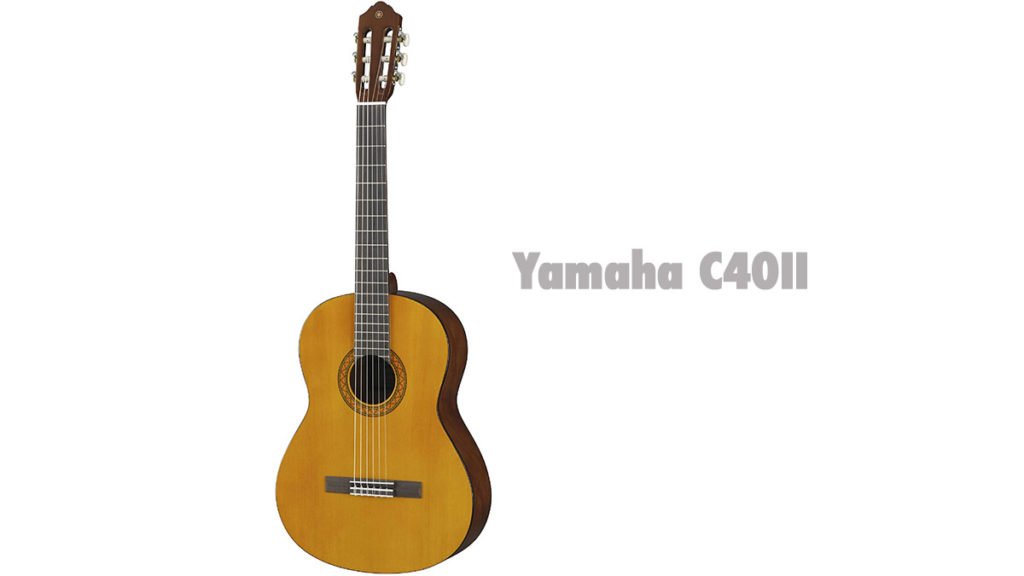Yamaha calls the C40 classical guitar a student guitar. Like many older guitarists, I too have had my brush with it ages ago (although I was no longer a novice then). Recently too, I’ve been wondering about how the old C40 has been doing. This review of the Yamaha C40 is based on some research I undertook to help some students.
Is the C40 still relevant in today’s crowded market of many beginner brands? The Yamaha C40 continues to be an ideal beginner guitar mainly due to its excellent construction, consistent quality and its low price. It is a regular, full-size classical guitar built to standard industry norms, not a truncated version.
The Yamaha C40 offers important features that are relevant and convincing to students, as well as their teachers.
Table of Contents
Factory-built on traditional lines
Regarding its own blend of factory methods with traditional craftsmanship, Yamaha has this to say.
Yamaha classical guitar craftsmen learned the fine art of guitar making directly from the masters. Under the tutelage of Manuel Hernandez and Eduardo Ferrer, Yamaha guitar craftsmen acquired skills… Yamaha has succeeded in blending the best and most critical aspects of traditional Spanish guitar making techniques with modern guitar manufacturing processes.
From Yamaha’s website
Many guitar players, casual or expert, will give Yamaha at least this much: great consistency in guitar build. Quality control in factory-built, as against custom-built (read expensive) guitars, is critical to earning customer trust. Quality control is equally critical to customers who live far from big cities and buy a musical instrument online on trust.
Perhaps to avoid the impression that a student guitar may be thought of as small size, every online store that sells the C40 makes sure to mention ’full size’. The C40’s scale length is the standard 650mm. Scale length is the distance between the vertical, white ’nut’ with stringing grooves at the headstock end and the slim, white ’saddle’ over which the strings pass at the bridge end.
The standard width at the first fret of classical guitars is 2 inches (50 mm) and the C40 has it pegged at that.
Choice of woods obviously matters in what is essentially a wooden instrument. The top wood (with the sound hole) is the most important surface for resonance and is usually cedar or spruce even in high-end instruments. The C40 has a spruce top.
But wait… it is more correctly called spruce laminate, which means thin slices of wood pasted together. The expensive spruce-top guitars don’t use laminates preferring a solid top instead. Solid top guitars, as you may have guessed, are costlier and sound fuller and brighter.
But, hey, it’s still spruce, accounting for the bright, trebly sound that everyone likes about the C40.
The back. sides and neck affect the resonance and sound quality a lot less. The C40 makes use of lesser known woods here, no doubt with an eye on affordability – Meranti and Nato. The fingerboard is made of rosewood, a well known choice, although ebony is more often used in mid-range to expensive guitars.
As we should expect in an inexpensive instrument, there are plastic components, notably the nut and the saddle.
To be fair, none of such things as wood choices or plastic components should worry a novice player. He or she is not buying the equivalent of a Ferrari, after all. It’s just a beginner’s guitar, people! As such, there are no serious consequences on these counts, you may rest assured.

The C40 is a professional product and the sound quality is good. In fact, there are many older players returning to the guitar after a gap of decades who just love the sound of a Yamaha classical guitar. The C40 has its own legion of fans for its sound.
Check out the price of the Yamaha C40II at Sweetwater.
The sweet sound of the C40
As anyone can easily tell, the player here is not a novice. Nor, for that matter, is the music here at anywhere close to novice repertoire. And yet here we are… an exquisite rendition of advanced repertoire… on a beginner guitar called the C40! Take that… or should we say Take Five? How does she do it?
This is the sort of demo that stops all further discussion on wood choices, plastic parts, manufacturing shortcuts, etc. If this player can get the C40 to sing like this, why really should a student bother about this spec being right or that spec being inadequate?
If anything, this proves a good artiste can play on anything and make it sound good. But it also means the potential for beautiful sound lies waiting within this instrument. It only needs to be found and unleashed.
Taken together with an affordable price, it is easy to see why the C40 still rules today.
Who is it for? Who is it not for?
We’ve seen that this review uses ‘novice’, ‘beginner’ and ‘student’ frequently – with good reason. I am following not just the manufacturer’s slotting but also a classification many consumers, including me, will concur with for the C40.
Yet there are different kinds of beginners – for some of whom this is the perfect choice but for a few others not really a good one.
Perfect for
- Children over eleven years old, for whom the standard recommendation is a full size guitar
- Adults of any age wishing to learn the mysteries of a nylon stringed guitar
- Formal students at an academy or with a private tutor in need of a starting guitar
- Older adults (perhaps with previous experience on a Yamaha acoustic) returning to music after a break and choosing to check out classical
- Steel string guitarists looking for a ’nylon touch’ to add to their music
- Intermediate classical guitarists, as a great second guitar to have, a practice guitar
- As a gift to a talented young relative or a friend’s child, substantial yet affordable
Not for
- Young children who should look at a truncated guitar – a 3/4 or 7/8 and other bewilderingly named size options
- Adults with small hands (debatable), but some are very clear they’d rather prefer a smaller 630mm guitar
- Folks interested in playing drums or tuba and the like 😉
If you’re interested in a broader discussion of classical guitar options available to the beginner, I recommend checking out my review of guitars for the beginner.
Answers to some questions about the C40
Q. Does it come with strings already fitted?
A. Yes, no seller sells a guitar without a set of strings in place.
Q. How many frets does this guitar have?
A. 19 frets. It is a standard number for full-size classical guitars.
Q. Is this a normal sized guitar or a mid-size one?
A. It is a normal, full-size guitar with a scale length of the regular 650mm. While at it, here are the other relevant facts.
| Guitar top | Laminate Spruce |
| Guitar back and sides | Meranti/Mahogany/Spruce |
| Guitar neck | Nato |
| Guitar fretboard | Rosewood |
| Strings type | Nylon |
| Scale length | 650 mm (25 9/16”) |
| Total length | 995 mm (39 3/16”) |
| Width at nut | 52 mm (2 1/16”) |
Q. Does it have a jack?
A. No. This is a purely acoustic instrument.
Q. Does this have a truss rod?
A. No. It is not a feature you will find at the inexpensive range of classical guitars.
Q. I have seen Indonesian mahogany being mentioned online as a wood used on the guitar. Why haven’t you mentioned it in your review?
On the C Series classical guitars page on the Yamaha site, they mention tonewoods being used from the local region based on availability. So far as I can tell from various online seller sites, the top always seems to be spruce (laminate), the fretboard always rosewood and the neck always Nato. It is the sides and back – which are less important to the tone of the instrument than the top – that seem to interchangeably use Meranti or Mahogany. These are the facts as they appear to be, but rather inconsequential in my opinion.
Q. Is there a difference between the C40 and C40II?
It is a vexing question, because no seller out there is clarifying the difference (if any) while selling both. The manufacturer too has no reference to the older C40 on their website. Amazon has (or certainly had, I’ve seen it) a reference on its C40 page saying a newer version of the model is available and linking to the C40II page. The newer version is about $20 cheaper though. Some independent websites are claiming there is a difference in the woods between the two models. It may not be a real difference. For either model, Yamaha has indicated they use different woods based on availability (for the sides and back, not the top).
Overall, I would think both models are more or less the same version at a slightly differing price. I would also guess that the company has stopped making the earlier C40 but the stores still have stock of it. Wish some responsible voice clarified it for us.
For a review of beginner classical guitars in general, read my What’s the Best Beginner Guitar? If you are evaluating a hybrid guitar – a cutaway acoustic-electric guitar with nylon strings and preamps – you should check out my article 6 Cutaway Classical Guitars with Preamps.
If you’re buying a 1/2 size classical guitar for your child, do read The Ideal 1/2 Size Guitar For Your Kid about another popular Yamaha model.
Check the price of the Yamaha C40II at Sweetwater.
If you prefer a Made in Spain beginner guitar for a little more expense, check out my Alhambra 1C review.
Happy beginnings!
